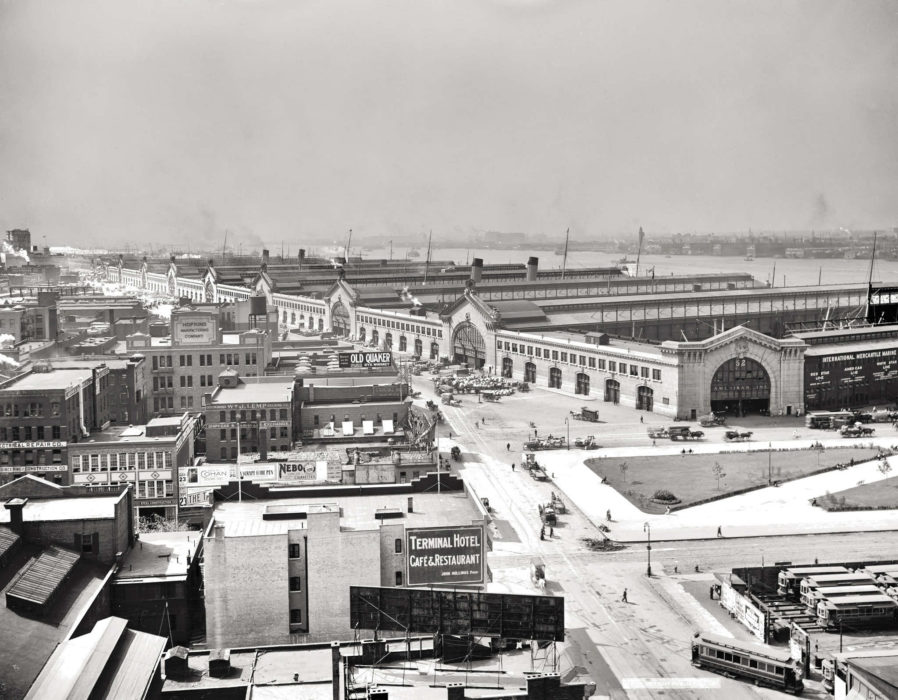‘ABDU’L-BAHÁ STEPPED OUT of his cabin on the Promenade Deck and set off down the corridor toward the ship’s bow. He and his party swept through the main foyer — bustling with passengers preparing for departure — up a flight of stairs to the Boat Deck, and then into the first-class lounge on the top of the ship. It was already overflowing when he reached it. More than 100 people had boarded the liner on this Thursday morning, December 5, 1912, to capture a final moment with ‘Abdu’l-Bahá before he set sail for Liverpool.

The SS Celtic, a 21,000-ton steamship of the White Star Line, lay moored along her port side at her pier on the Hudson River near West 23rd Street. She was 700 feet long — nineteen feet and one inch longer than her sister, the Cedric, which had delivered ‘Abdu’l-Bahá to New York 238 days earlier. Two buff-colored funnels rose amidships, capped in black, and the Celtic’s dark iron hull reached down beneath the pier out of sight to the cold December waters below.
Someone handed ‘Abdu’l-Bahá a large bunch of red American Beauty roses when he entered the lounge at eleven o’clock. This light and cheery space, forty feet wide and almost as long, was the ship’s primary indoor gathering place. Visitors filled the three-sided nooks along the walls, which were formed by dark leather seats built in securely under the windows. Others perched on the soft barrel-shaped chairs in the middle of the room; they were upholstered in tapestry and set around heavy, ornately carved tables where passengers might play cards or enjoy an after-dinner cup of coffee during their long overseas voyages.
‘Abdu’l-Bahá moved among the tables, speaking a few final words to this person and then to that, offering to some of them a rose. As the top of the hour approached he stood and began to speak in his deep resonant Persian, the sentences translated into English, one by one, as he intoned them.
“The earth is one native land, one home; and all mankind are the children of one Father,” he said. “God has created them, and they are the recipients of His compassion. Therefore, if anyone offends another, he offends God. It is the wish of our heavenly Father that every heart should rejoice and be filled with happiness, that we should live together in felicity and joy. The obstacle to human happiness is racial or religious prejudice, the competitive struggle for existence and inhumanity toward each other.”
Soft sounds of sobbing unsettled the surrounding silence.
“Until man reaches this high station,” ‘Abdu’l-Bahá said, “the world of humanity shall not find rest, and eternal felicity shall not be attained. But if man lives up to these divine commandments, this world of earth shall be transformed into the world of heaven, and this material sphere shall be converted into a paradise of glory. It is my hope that you may become successful in this high calling so that like brilliant lamps you may cast light upon the world of humanity and quicken and stir the body of existence like unto a spirit of life. This is eternal glory. This is everlasting felicity. This is immortal life. This is heavenly attainment. This is being created in the image and likeness of God.”

‘Abdu’l-Bahá then took a seat in the corner of the room, and the guests gathered round, continuing to converse until the moment finally came for them to disembark. ‘Abdu’l-Bahá walked out along the side of the Boat Deck. He leaned on the railing with his right arm and looked down at the crowd gazing back at him. When the clock struck noon, the Celtic’s engines began to hum. The great ship began to move slowly astern, the crowd on the pier tracking ‘Abdu’l-Bahá’s white turban as the vessel pulled slowly backward into the flowing waters of the Hudson. Once the ship had cleared the dock, the pilot turned his wheel to the right, then reversed the engines and steamed south with the current, past the rising skyscrapers of downtown.
Back on April 11, when ‘Abdu’l-Bahá had first steamed up the Hudson, he had called the towers of lower Manhattan “the minarets of Western World commerce and industry.” Now, as the crowd on the dock faded into the distance, ‘Abdu’l-Bahá could see that the new Woolworth Building, still under construction at Park Place and Broadway, had superseded them, climbing sixty stories to top out at 792 feet. A few minutes later the ship skirted the immigrant landing station at Ellis Island, and steamed past the green copper cladding of the massive statue that stood guard over the bay.
Within thirty minutes the SS Celtic had traversed the upper bay, slipped the three-mile route of the Narrows, passed the breakwater at the southern tip of Long Island, and pushed out over a smooth sea, bound for Liverpool and the Old World.







